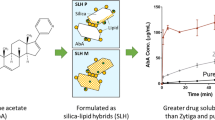Abstract
Unique physical–chemical properties of amorphous silica surface provide certain biological effects: high hydrophilia, affinity to proteins, adsorption of microorganisms and of some low-molecular substances. All of them, as well as the capability of amorphous silica to modulate pharmacokinetics and biotransformation of other medicines by joint administration, allow us to use it not only as a medication of applicational and oral therapy, but also as a matrix or a carrier to create combined drugs. A number of such perspective medical products as Aquasil, Siloglucan, Phytosilard, Lysosil, Lysetox, Flotoxan are now at different stages of development, preclinical, and clinical studies.
Access this chapter
Tax calculation will be finalised at checkout
Purchases are for personal use only
Similar content being viewed by others
References
Iler RK (1979) The chemistry of silica. Wiley, Chichester, 1979.
Chuiko AA, Gorbik PP, Pogorelyi VK et al (2007) Principles of development and efficiency of application of medicines based on highly disperse silica in the experiment and clinic. In: Shpak AP, Gorbik PP (eds.), Physicochemistry of nanomaterials and supramolecular structures, Vol. 1. Naukova Dumka, Kiev, pp. 9–44.
Gorbik PP, Pentyk OO, Shtatko OI (2008) Perspectives of creation of combined medicinal preparations based on highly disperse silica. Nanosyst Nanomater Nanotechnol (Ukr) 6: 315–330.
Avtsyn AP, Zhavoronkov AA, Rish MA, Strochkova LS (1991) Human microelementoses: aetiology, classification, organopathology. AMS USSR, Medicine, Moscow, pp. 323–337.
Stratta P, Canavese C, Messuerotti A et al (2001) Silica and renal diseases: no longer a problem in the 21st century? J Nephrol 14: 228–247.
Donaldson K, Stone V, Duffin R et al (2001) The quartz hazard: effects of surface and matrix on inflammogenic activity. J Environ Pathol Toxicol Oncol 20 (Suppl 1): 101–110.
Chuiko AA (ed.) (2003) Medical chemistry and clinical application of silicon dioxide. Naukova Dumka, Kiev.
Chuiko AA (ed.) (2001) Chemistry of silica surface. UkrINTEI, Kiev.
Tentsova AI, Alyushin MT (eds.) (1985) Polymers in pharmacy. Medicine, Moscow.
Moroz VM, Chuiko OO, Pentyuk OO (1999) Achievements in development of medicines based on highly disperse silica. Vistn Vinnuts St Med Univers (Ukr) 3: 1–3.
Pentyk OO, Gerashchenko II, Verbilovsky YP et al (2001) Antidiarrheal preparation Siloglucan. Ukraine Patent No. 34129A (publ. 15.02.01, Bull. No. 1).
Verbilovsky YP, Gerashchenko II, Statko EI, Yushcenko TI (2003) Mechanochemical preparation and investigation of composite with highly disperse silica, sodium and potassium chlorides, sodium citrate and glucose. Chim Pharm J (Russ) 37(12): 45–48.
Verbilovsky YP, Gerashchenko II, Statko EI, Yushcenko TI (2002) Development and pre-clinical study of sorption-salt composite Siloglucan. Clin Pharm (Ukr) 6(3): 51.
Kutelmakh OI, Chumakova YG, Shtatko OI (2004) Comparative evaluation of the influence of Silics and Phytosilard on the behavior of aseptic inflammation of soft tissues of mouth cavity of rats. Vistn Stomatol (Ukr) 2: 13–18.
Kutelmakh OI, Chumakova YG (2006) Influence of complex preparations based on Silics on paradont tissues on experimental paradontosis of rats. Vistn Stomatol (Ukr) 1: 12–18.
Gerashchenko II, Viltsanyuk OA, Zheliba MD et al (1998) Method of treatment of pyoinflammatory diseases. Ukraine Patent No. 20765 A (publ. 27.02.98, Bull. No. 1).
Gerashchenko II, Vievsky AM, Bogomaz VI (1996) Stabilization of proteolytic enzymes in solutions of some bis-quaternary ammonium compounds. Pharm J (Ukr) 5–6: 112–115.
Gerashchenko II, Voronin EP, Barylo AS et al (2001) Mechanosorptional preparation of composites with highly disperse silica, trypsin and cationic surfactants. Chim Pharm J (Russ) 35(2): 16–17.
Gerashchenko II, Sander SV, Bondarchuk OI et al (1997) Bandage for wounds. Patent 15308 A UA, A61F13/04. 94117598 (30.06.1997, Bull. No. 3).
Shevchenko YM, Gerashchenko II, Viltsanyuk OA (2000) Wound healing preparation and method of its preparation. Ukraine Patent UA 32088 5A 61 A 31/695, A 61 K 31/14. No. 98126795 (15.12.2000, Bull. No. 7-11).
Viltsanyuk OA, Khutoryansky MO, Osolodchenko TP et al (2007) Ground of utilization of cation antiseptic surfactants and sorbents for prophylaxis of septic complications. Khark Surg School (Ukr) 2: 166–170.
Viltsanyuk OA (2005) Experimental evaluation of efficiency of Flotoxan on treatment of purulent wounds. Vistn Morphol VNMU (Ukr) 1: 38–42.
Viltsanyuk OA, Gerashchenko II, Cheplyaka OM (2008) Experimental and clinical ground of utilization of hydrophilic-hydrophobic silica-containing composites for local treatment of purulent wounds. Khark Surg School (Ukr) 1: 53–57.
Ilchenko OV (2001) Means of increase in the amounts of adsorbed substance immobilized on unit of surface area of carrier. Ukraine Patent No. 32545, B 01 J 8/00, B 01 J 19//00, Bull. No. 1.
Ilchenko AV (1999) Kinetics of sorption of alkaloids on enterosobent Polysorb MP. Abstracts of presentations at All-Russian Conference “Sorptional, electrochemical and gravitational methods in modern medicine”, October 26–28, Moscow, pp. 44–45.
Viltsanyuk OO, Gerashchenko II, Oshovsky AI, Chuiko OO (2001) Method of prophylaxis of septic complications after surgeries of gastrointestinal tract. Ukraine Patent No. 41529A (publ. 17.09.01, Bull No. 8).
Oshovsky AI, Gerashchenko II, Viltsanyuk OO (2001) Preparation and preclinical study of biosoluble capsules with given properties. Pharmacom (Ukr) 3: 54–57.
Viltsanyuk OO, Gerashchenko II, Oshovsky AI (1999) Utilization of soluble capsules filled by sorbent for prophylaxis of postoperative peritonitis. Vistnk VMSU (Ukr) 3: 216–217.
Author information
Authors and Affiliations
Editor information
Editors and Affiliations
Rights and permissions
Copyright information
© 2009 Springer Science+Business Media B.V.
About this chapter
Cite this chapter
Chuiko, O. et al. (2009). Application Efficiency of Complex Preparations Based on Nanodisperse Silica in Medical Practice. In: Shpak, A., Gorbyk, P. (eds) Nanomaterials and Supramolecular Structures. Springer, Dordrecht. https://doi.org/10.1007/978-90-481-2309-4_5
Download citation
DOI: https://doi.org/10.1007/978-90-481-2309-4_5
Published:
Publisher Name: Springer, Dordrecht
Print ISBN: 978-90-481-2308-7
Online ISBN: 978-90-481-2309-4
eBook Packages: Chemistry and Materials ScienceChemistry and Material Science (R0)




